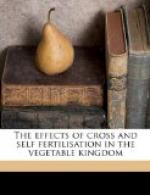The intercrossed plants of the same stock in four out of the five successive generations plainly exceeded in height the self-fertilised plants. The latter in the fourth generation were crossed by a fresh stock, and the seedlings thus obtained were put into competition with the self-fertilised plants of the fifth generation. The crossed plants exceeded the self-fertilised in height in the ratio of 100 to 66, and in weight as 100 to 23; but this difference, though so great, is not much greater than that between the intercrossed plants of the same stock in comparison with the self-fertilised plants of the corresponding generation. This case, therefore, seems at first sight opposed to the rule that a cross with a fresh stock is much more beneficial than a cross between individuals of the same stock. But as with Eschscholtzia, the reproductive system was here chiefly benefited; for the plants raised from the cross with the fresh stock were to the self-fertilised plants in fertility, both lots being naturally fertilised, as 100 to 46, whereas the intercrossed plants of the same stock were to the self-fertilised plants of the corresponding fifth generation in fertility only as 100 to 86.
Although at the time of measurement the plants raised from the cross with the fresh stock did not exceed in height or weight the intercrossed plants of the old stock (owing to the growth of the former not having been completed, as explained under the head of this species), yet they exceeded the intercrossed plants in fertility in the ratio of 100 to 54. This fact is interesting, as it shows that plants self-fertilised for four generations and then crossed by a fresh stock, yielded seedlings which were nearly twice as fertile as those from plants of the same stock which had been intercrossed for the five previous generations. We here see, as with Eschscholtzia and Dianthus, that the mere act of crossing, independently of the state of the crossed plants, has little efficacy in giving increased fertility to the offspring. The same conclusion holds good, as we have already seen, in the analogous cases of Ipomoea, Mimulus, and Dianthus, with respect to height.
10. Nicotiana tabacum.
My plants were remarkably self-fertile, and the capsules from the self-fertilised flowers apparently yielded more seeds than those which were cross-fertilised. No insects were seen to visit the flowers in the hothouse, and I suspect that the stock on which I experimented had been raised under glass, and had been self-fertilised during several previous generations; if so, we can understand why, in the course of three generations, the crossed seedlings of the same stock did not uniformly exceed in height the self-fertilised seedlings. But the case is complicated by individual plants having different constitutions, so that some of the crossed and self-fertilised seedlings raised at the same time from the same parents behaved differently. However this may be, plants raised from self-fertilised plants




